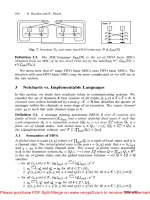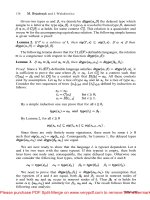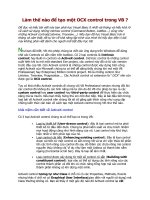Tài liệu CONCUR 2004 – Concurrency Theory- P19 docx
Bạn đang xem bản rút gọn của tài liệu. Xem và tải ngay bản đầy đủ của tài liệu tại đây (126.25 KB, 7 trang )
526
M. Viswanathan and R. Viswanathan
with the HFL formula flc-diag expressing a property of the form prescribed by
Theorem 2. The properties of the terms decode and init defined in Table 4 are
given by the following theorem:
Theorem 3. Let be a closed well-named FLC formula over the action set A.
1.
2.
Consider any subformula and FLC environment
For any function such that
for every
free in
The
heart
of the
construction
is
decode
that
shows
how to
decode
(in
HFL)
the
transition system representing an FLC formula. Its definition given in Table 4
is easiest understood on the basis of its property given in Theorem 3, with
the variable read as standing for the function representing an
environment and the variable in each of the cases read as standing
for the singleton set On an argument the formula is decoded in
cases according to its outermost form which in turn is inferred based on which
of the propositional constants holds in (standing for For all
constructs other than variables and fixed points, their corresponding cases can be
understood by close analogy with the HFL-translation of these constructs given
in Table 3 together with the understanding that and yield singleton
sets including the corresponding subformulas of and that for constant literals
term yields the set of states in which the literal holds. If is a variable,
we evaluate the environment on the set (as given by the property
of which is yielded by the term If is a fixed point formula, we
correspondingly bind (using or v
)
a new variable and decode the subformula
of (given by but in an environment that is obtained by modifying the
current environment to map (given by to
(the case-term used for
the environment argument to in the fixed point cases yields this updated
environment). This ensures that when decoding the subformulas of any use
of a variable corresponding to this recursive definition will be decoded as
The decoding of the fixed-point cases explains the presence of the environment
argument
in
defining
decode.
Finally,
it is
worth noting
that:
(1)
decode
is a
recursive definition of a higher-order function, and (2) because decode is defined
by case-analysis, it is not monotonic in the argument (standing for the formula
being decoded). These features of HFL are therefore crucial to its definition.
As an easy corollary of Theorem 3, we get the relevant properties of the terms
flc-sem and flc-diag.
Corollary 3. For any closed well-named FLC formula over the action set A,
we have that
TEAM LinG
Please purchase PDF Split-Merge on www.verypdf.com to remove this watermark.
A Higher Order Modal Fixed Point Logic
527
1.
2.
iff
Combined
with Theorem
2
this
gives
us
that
the HFL
formula
flc-diag
is a
characteristic formula for a property of finite transition systems that is inex-
pressible in FLC, and thus HFL is strictly more expressive than FLC even over
finite transition systems.
References
1.
2.
3.
4.
5.
6.
7.
8.
9.
10.
11.
12.
13.
14.
15.
Müller-Olm, M.: A Modal Fixpoint Logic with Chop. In: Proceedings of the Sym-
posium on the Theoretical Aspects of Computer Science Volume 1563 of Lecture
Notes in Computer Science., Springer (1999) 510–520
Pnueli. A.: In transition from global to modular temporal reasoning about pro-
grams. In: Logics and Models of Concurrent Systems. NATO ASI Series. Springer-
Verlag (1984) 123–144
Misra, J., Chandy, K.M.: Proofs of network processes. IEEE Transactions on
Software Engineering SE-7 (1981) 417–426
Abadi, M., Lamport, L.: Composing specifications. ACM Transactions on Pro-
gramming Languages and Systems 15 (1993) 73–132
Abadi, M., Lamport, L.: Conjoining specifications. ACM Transactions on Pro-
gramming Languages and Systems 17 (1995) 507–534
McMillan, K.: Circular compositional reasoning about liveness. In Pierre, L.,
Kropf, T., eds.: CHARME 99: Correct Hardware Design and Verification. Volume
1703 of Lecture Notes in Computer Science., Springer-Verlag (1999) 342-345
Henzinger, T.A., Qadeer, S., Rajamani, S.K., Tasiran, S.: An assume-guarantee
rule for checking simulation. In: Gopalakrishnan, G., and Windley, P., eds: FMCAD
98: Formal Methods in Computer-aided Design, Volume 1522 of Lecture Notes in
Computer Science., Springer-Verlag (1998) 421–432
Viswanathan, M., Viswanathan, R.: Foundations of Circular Compositional Rea-
soning. In: Proceedings of the International Colloquim on Automata, Languages
and Programming. Lecture Notes in Computer Science, Springer (2001)
Kozen, D.: Results on the propositional Theoretical Computer Science,
27 (1983) 333–354
Stirling, C.: Modal and Temporal Logics. In Handbook of Logic in Computer
Science. Volume 2. Claredon Press, Oxford, UK (1992) 477–563
Emerson, E.A., Jutla, C.S., Sistla, A.P.: On model checking for the and
its fragments. Theoretical Computer Science 258 (2001) 491–522
Lange, M., Stirling, C.: Model Checking Fixed Point Logic with Chop. In: Proceed-
ings of the Foundations of Software Science and Computation Structures. Volume
2303 of Lecture Notes in Computer Science., Springer (2002) 250–263
Lange, M.: Local model checking games for fixed point logic with chop. In: Pro-
ceedings of the Conference on Concurrency Theory, CONCUR’02. Volume 2421 of
Lecture Notes in Computer Science., Springer (2002) 240–254
Hopcroft, J.E., Ullman, J.D.: Introduction to Automata Theory, Languages and
Computation. Addison-Wesley (1979)
Burkart, O. Caucal, D., Moller, F., Steffen, B.: Verification on Infinite Structures.
In: Handbook of Process Algebra. Elsevier Science Publishers (2001) 545–623
TEAM LinG
Please purchase PDF Split-Merge on www.verypdf.com to remove this watermark.
528
M. Viswanathan and R. Viswanathan
16.
17.
18.
Hirshfeld, Y., Jerrum, M., Moller, F.: A polynomial algorithm for deciding bisim-
ilarity of normed context-free processes. Theoretical Computer Science 15 (1996)
143–159
Sénizergues, G.: Decidability of bisimulation equivalence for equations graphs of
finite out-degree. In: Proceedings of the IEEE Sysmposium on the Foundations of
Computer Science. (1998) 120–129
Tarski, A.: A lattice-theoretical fixpoint theorem and its applications. Pacific
Journal of Mathematics 5 (1955) 285–309
TEAM LinG
Please purchase PDF Split-Merge on www.verypdf.com to remove this watermark.
Author Index
Abdulla, Parosh Aziz 35
Amadio, Roberto M. 68
Andrews, Tony 1
Baldan, Paolo 83
Baudru, Nicolas 99
Berger, Martin 115
131
Bollig, Benedikt 146
Borgström, Johannes 161
Bozga, Liana 177
Brázdil, Tomáš 193
Briais, Sébastien 161
Brookes, Stephen 16
Bruns, Glenn 209
Bugliesi, Michele 225
Caires, Luís 240
Cîrstea, Corina 258
Clarke, Edmund 276
Colazzo, Dario 225
Corradini, Andrea 83
Crafa, Silvia 225
Dal Zilio, Silvano 68
Danos, Vincent 292
Ene, Cristian 177
Gay, Simon 497
Groote, Jan Friso 308
Hirschkoff, Daniel 325
Jagadeesan, Radha 209
Jeffrey, Alan 209
Jonsson, Bengt 35
König, Barbara 83
340
355
Krivine, Jean 292
193, 371
Lakhnech, Yassine 177
Laroussinie, F. 387
Leroux, Jérôme 402
Leucker, Martin 146
Lozes, Étienne 240
Ma, Qin 417
Maranget, Luc 417
Markey, Nicolas 387, 432
Melliès, Paul-André 448
Mokrushin, Leonid 340
Morin, Rémi 99
Nestmann, Uwe 161
Nilsson, Marcus 35
O’Hearn, Peter W. 49
Pattinson, Dirk 258
Qadeer, Shaz 1
Rajamani, Sriram K. 1
Raskin, Jean-François 432
Ravara, António 497
355
Rehof, Jakob 1
Riely, James 209
Saksena, Mayank 35
Schnoebelen, Philippe 371, 387
193
355
Sutre, Grégoire 402
Tabuada, Paulo 466
Talupur, Muralidhar 276
Thiagarajan, P.S. 340
Touili, Tayssir 276
Varacca, Daniele 481
Vasconcelos, Vasco 497
Veith, Helmut 276
Viswanathan, Mahesh 512
Viswanathan, Ramesh 512
Völzer, Hagen 481
Walukiewicz, Igor 131
Willemse, Tim 308
Winskel, Glynn 481
Xie, Yichen 1
Yi, Wang 340
TEAM LinG
Please purchase PDF Split-Merge on www.verypdf.com to remove this watermark.
This page intentionally left blank
TEAM LinG
Please purchase PDF Split-Merge on www.verypdf.com to remove this watermark.









